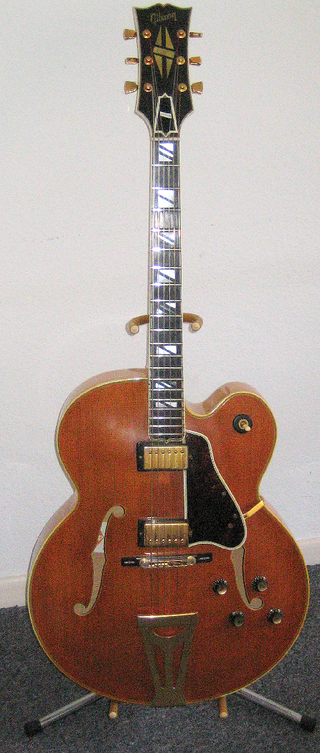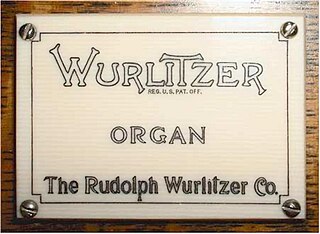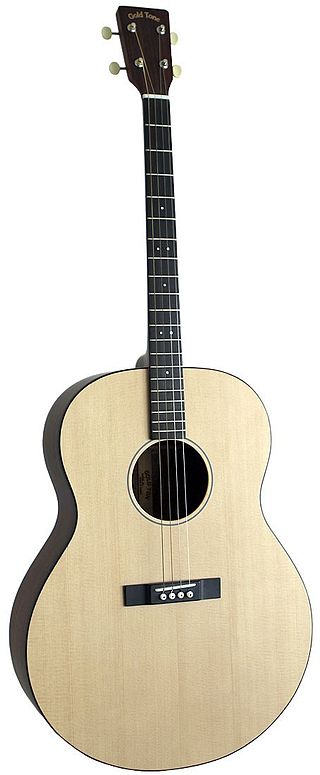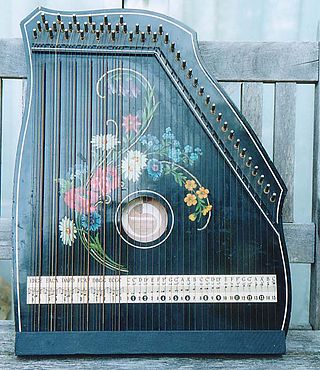
Lyon & Healy Harps, Inc. is an American musical instrument manufacturer based in Chicago, Illinois and is a subsidiary of Salvi Harps. Today best known for concert harps, the company's Chicago headquarters and manufacturing facility contains a showroom and concert hall. George W. Lyon and Patrick J. Healy began the company in 1864 as a sheet music shop. By the end of the 19th century, they manufactured a wide range of musical instruments—including not only harps, but pianos, guitars, mandolins, banjos, ukuleles and various brass and other percussion instruments.

A mandolin is a stringed musical instrument in the lute family and is generally plucked with a pick. It most commonly has four courses of doubled strings tuned in unison, thus giving a total of eight strings. A variety of string types are used, with steel strings being the most common and usually the least expensive. The courses are typically tuned in an interval of perfect fifths, with the same tuning as a violin. Also, like the violin, it is the soprano member of a family that includes the mandola, octave mandolin, mandocello and mandobass.

Epiphone is an American musical instrument brand that traces its roots to a musical instrument manufacturing business founded in 1873 by Anastasios Stathopoulos in Smyrna, Ottoman Empire, and moved to New York City in 1908. After taking over his father's business, Epaminondas Stathopoulos named the company "Epiphone" as a combination of his own nickname "Epi" and the suffix "-phone" in 1928, the same year it began making guitars. From the 1930s through to the early 1950s, Epiphone produced a range of both acoustic and (later) electrified archtop guitars that rivalled those produced by Gibson and were the instruments of choice of many professionals; a smaller range of flat-top guitars were also produced, some designations of which were later continued during the Gibson-owned era for the company.

An archtop guitar is a hollow acoustic or semi-acoustic guitar with a full body and a distinctive arched top, whose sound is particularly popular with jazz, blues, and rockabilly players.

The Rudolph Wurlitzer Company, usually referred to as simply Wurlitzer, is an American company started in Cincinnati in 1853 by German immigrant (Franz) Rudolph Wurlitzer. The company initially imported stringed, woodwind and brass instruments from Germany for resale in the United States. Wurlitzer enjoyed initial success, largely due to defense contracts to provide musical instruments to the U.S. military. In 1880, the company began manufacturing pianos and eventually relocated to North Tonawanda, New York. It quickly expanded to make band organs, orchestrions, player pianos and pipe or theatre organs popular in theatres during the days of silent movies.

Hohner Musikinstrumente GmbH & Co. KG is a German manufacturer of musical instruments, founded in 1857 by Matthias Hohner (1833–1902). The roots of the Hohner firm are in Trossingen, Baden-Württemberg. Since its foundation, and though known for its harmonicas, Hohner has manufactured a wide range of instruments, such as kazoos, accordions, recorder flutes, melodicas, banjos, electric, acoustic, resonator and classical guitars, basses, mandolins and ukuleles.

Lloyd Allayre Loar (1886–1943) was an American musician, instrument designer and sound engineer. He is best known for his design work with the Gibson Mandolin-Guitar Mfg. Co. Ltd. in the early 20th century, including the F-5 model mandolin and L-5 guitar. In his later years he worked on electric amplification of stringed instruments, and demonstrated them around the country. One example, played in public in 1938 was an electric viola that used electric coils beneath the bridge, with no back, able to "drown out the loudest trumpet."
Slingerland is a United States manufacturer of drums. The company was founded in 1912 and enjoyed several decades of prominence in the industry before the 1980s. After ceasing operation in the early 1980s, Slingerland was acquired by Gibson, who briefly revived it and owned it until November 2019, before selling Slingerland to DW Drums, who have announced the intention of re-launching the brand. Slingerland is strongly associated with jazz drummers, such as Gene Krupa and Buddy Rich, who played signature instruments made by the company. Although primarily known for its drums, in the 1930s Slingerland also produced electric and acoustic guitars, violins, mandolins, banjos and ukuleles.

Orville H. Gibson was an American luthier who founded the Gibson Guitar Company in Kalamazoo, Michigan in 1902, makers of guitars, mandolins and other instruments.

The mandocello is a plucked string instrument of the mandolin family. It is larger than the mandolin, and is the baritone instrument of the mandolin family. Its eight strings are in four paired courses, with the strings in each course tuned in unison. Overall tuning of the courses is in fifths like a mandolin, but beginning on bass C (C2). It can be described as being to the mandolin what the cello is to the violin.

The tenor guitar or four-string guitar is a slightly smaller, four-string relative of the steel-string acoustic guitar or electric guitar. The instrument was initially developed in its acoustic form by Gibson and C.F. Martin so that players of the four-string tenor banjo could double on guitar.

The guitar zither is a musical instrument consisting of a sound-box with two sets of unstopped strings. One set of strings is tuned to the diatonic, chromatic, or partially chromatic scale and the other set is tuned to make the various chords in the principal key of the melody strings.

A headstock or peghead is part of a guitar or similar stringed instruments such as a lute, mandolin, banjo, ukulele and others of the lute lineage. The main function of a headstock is to house the tuning pegs or other mechanism that holds the strings at the "head" of the instrument; it corresponds to a pegbox in the violin family. At the "tail" of the instrument the strings are usually held by a tailpiece or bridge. Machine heads on the headstock are commonly used to tune the instrument by adjusting the tension of strings and, consequently, the pitch of sound they produce.
A solid-body musical instrument is a string instrument such as a guitar, bass or violin built without its normal sound box and relying on an electromagnetic pickup system to directly detect the vibrations of the strings; these instruments are usually plugged into an instrument amplifier and loudspeaker to be heard. Solid-body instruments are preferred in situations where acoustic feedback may otherwise be a problem and are inherently both less expensive to build and more rugged than acoustic electric instruments.

Kay Musical Instrument Company was an American musical instrument manufacturer established in 1931 by namesake Henry "Kay" Kuhrmeyer and based in Chicago, Illinois. It was formed when Kuhrmeyer bought out his financial backers in the instrument manufacturer Stromberg-Voisinet. They produced guitars, mandolins, banjos, ukuleles and were known for their use of lamination in the construction of arched top instruments.

The Mandobass is the largest member of the mandolin family, sometimes used as the bass instrument in mandolin orchestras. It's essentially an Enormous Acoustic Bass shaped like an A Style Mandolin. This Bass is so large that players usually hold it like a double bass—upright and supported on an endpin that rests on the floor. The neck-scale length on a full-size mando-bass is similar to that of a standard orchestral double bass viol: about 43 inches (110 cm). The instrument is otherwise similar to the smaller, higher-pitched members of the mandolin family, having a fretted neck, a headstock with geared tuning machines, and a large resonating body often—but not always—shaped like other mandolins.

A resonator mandolin or "resophonic mandolin" is a mandolin whose sound is produced by one or more metal cones (resonators) instead of the customary wooden soundboard. These instruments are sometimes referred to as "Dobro mandolins," after pioneering instruments designed and produced by the Dopyera Brothers, which evolved into a brand name. The trademark "Dobro" is currently the property of the Gibson Guitar Corporation. When Gibson acquired the trademark in 1993, they announced that they would defend their right to its exclusive use.

Gibson Brands Inc. is an American manufacturer of guitars, other musical instruments, and professional audio equipment from Kalamazoo, Michigan, and now based in Nashville, Tennessee. The company was formerly known as Gibson Guitar Corporation and renamed Gibson Brands Inc. on June 11, 2013.
Izzy Miller is an American guitarist, singer, and songwriter. His first success came with his band Storage with the release of their 2009 single "Just a Little More". Miller left Storage in 2010 and began a solo career. After releasing Back From Nowhere, his first solo album, in 2010, he paired up with drummer Smokin' Joey Gambrell. Miller and Gambrell went on to release Who Is That? Nobody in 2012.

The mandolin has had a place in North American culture since the 1880s, when a "mandolin craze" began. The continent was a land of immigrants, including Italian immigrants, some of whom brought their mandolins with them. In spite of the mandolin having arrived in America, it was not in the cultural consciousness until after 1880 when the Spanish Students arrived on their international performing tour. Afterwards, a "mandolin craze" swept the United States, with large numbers of young people taking up the instrument and teachers such as Samuel Siegel touring the United States. The fad died out after World War I, but enough had learned the instrument that it remained. The mandolin found a new surge with the music of Bill Monroe; the Gibson F-5 mandolin he played, as well as other archtop instruments, became the American standard for mandolins. Bowlback mandolins were displaced. The instrument has been taken up in blues, bluegrass, jug-band music, country, rock, punk and other genres of music. While not as popular as the guitar, it is widespread across the country.
















